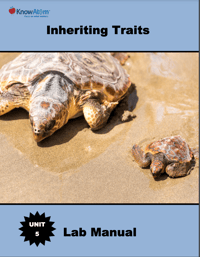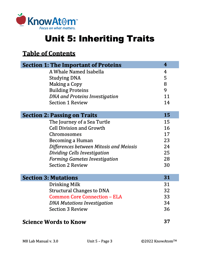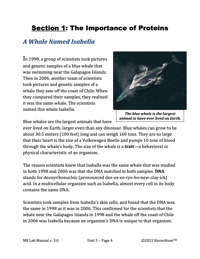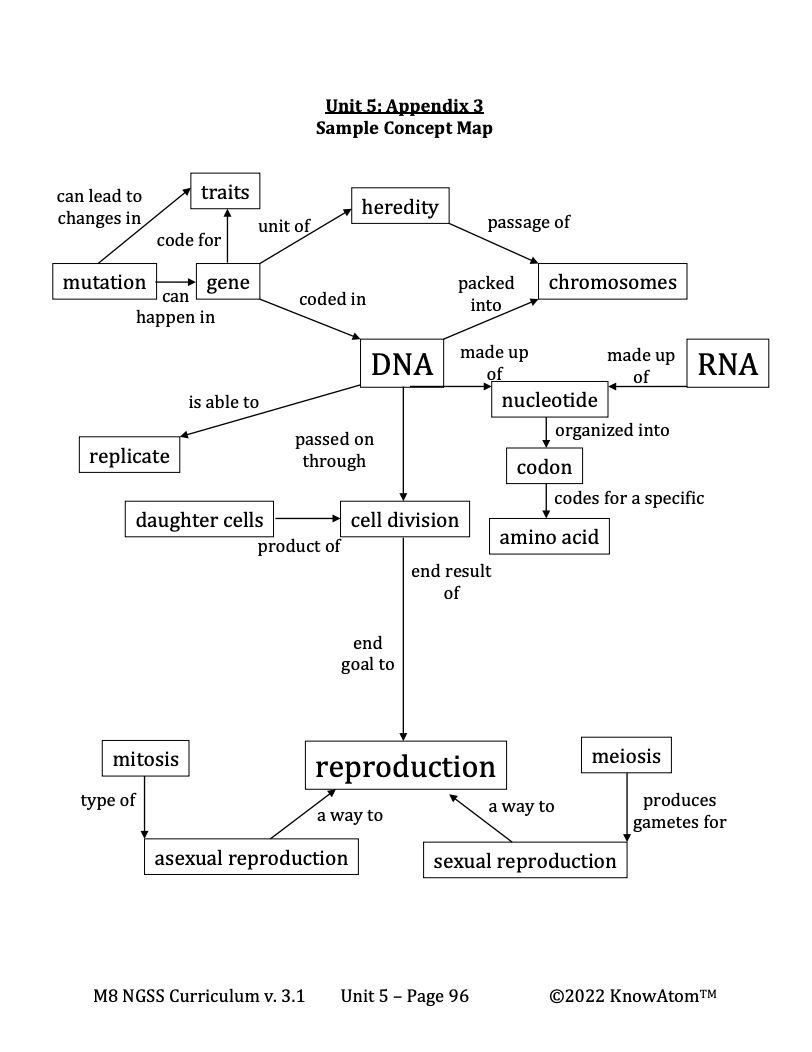Science background provides teachers with more in-depth information on the phenomena students explore in this unit. Below is an excerpt from this section on reproduction.
Mitosis
After DNA replicates, there is an exact copy of each chromosome. The identical chromosomes are called sister chromatids, and they are linked together by the centromere. DNA replication produces an exact copy of each chromosome. The two identical chromosomes are called sister chromatids.
Once a cell has replicated its DNA and there are sister chromatids, the cell gets ready to divide so it can pass along its genetic information to its offspring. There are several reasons why cells divide. One important reason is growth. The more cells an organism has, the larger that organism is. For example, humans start off as a single cell. By the time they are adults, they have trillions of cells. Blue whales have roughly 1,000 times more cells than humans.
Cell division also allows cells to repair damaged cells or replace dead cells. For example, human skin cells constantly divide so they can replace damaged or dead skin cells. Muscle cells also divide frequently to replace cells damaged by exercise or injury.
Cell division allows cells to reproduce. Reproduction is the ability of a mature organism to have offspring. Almost all cell division happens through a process called mitosis. Mitosis is a form of cell division that takes place in eukaryotic cells and results in two daughter cells with the same number of chromosomes as the parent cell.
Steps of Mitosis
There are four phases as a parent cell separates its chromosomes into two daughter cells.
Phase 1: Prophase— When the cell is ready to divide, DNA is wrapped even more tightly, and the chromosomes become visible. Each chromosome consists of the two sister chromatids formed during replication. The nuclear membrane breaks down and the chromosomes are freed from the nucleus. Small fibers called spindle fibers begin to grow from the centrosomes on opposite sides of the cell and attach to each sister chromatid at its centromere.
Phase 2: Metaphase— During metaphase, the chromosome pairs line up in the middle of the cell end- to-end. This formation ensures that each daughter cell will receive one copy of each chromosome.
Phase 3: Anaphase—Separation begins. The sister chromatids separate and the spindle fibers pull one complete set of an organism’s chromosomes to each end of the cell. For humans, 46 chromosomes move to each end of the cell. Each side receives the same number and kind of chromosomes as the parent cell.
Phase 4: Telophase—During telophase, the chromosomes reach opposite ends of the cell. Nuclear envelopes reassemble and enclose each cell’s set of chromosomes in a nucleus. The chromosomes become indistinct chromatin.
After telophase, most cells undergo a process called cytokinesis in which the rest of the cell splits apart, resulting in two separate daughter cells.
Benefits & Drawbacks
The result of mitosis is two daughter cells that are exact replicas of each other and the parent cell. In a multicellular eukaryotic organism, mitosis is how the organism grows. In a single-celled eukaryotic organism, mitosis is how the organism reproduces because the daughter cells are new organisms.
This is a form of asexual reproduction because it requires only one parent. Asexual reproduction is the most ancient method for passing on genetic material. The passing on of traits from parents to offspring is called heredity. Most unicellular organisms reproduce asexually, although a few multicellular organisms also reproduce this way. In prokaryotic cells, which do not have a nucleus to hold their genetic material, cell division is similar to mitosis because the cell replicates its DNA and the two copies split into two halves of a dividing cell. The result is two daughter cells that have the same genetic material as the parent cell.
From a reproductive standpoint, there are certain advantages to this process. Organisms do not need to expend time or energy searching for a mate, and all of an organism’s genes are passed on to its children. It also can occur rapidly; for example, bacteria can divide several times per hour.
However, there is very little genetic diversity in asexual reproduction. Because one parent passes along an exact genetic replica, the same genes are passed down from generation to generation. If one individual cannot overcome a type of disease or a rapid climate change, then all other offspring from the same parent are equally vulnerable.
Meiosis
Nature’s answer to this problem of lack of diversity was sexual reproduction, which creates offspring with the combined genetic information of a male and a female. The combination of genes ensures that each offspring has a different set of traits.
Humans and other complex organisms reproduce sexually through fertilization—the fusion of two gametes (cells that only contain half of an organism’s chromosomes). When a gamete from a male combines with a gamete from a female, the two joined gametes create a new individual that has a complete set of chromosomes.
Gametes are formed during a special kind of cell division called meiosis, which only happens when cells in sexually reproducing organisms prepare for reproduction. In meiosis, the cell divides twice, resulting in four daughter cells, each with half the chromosome number of the parent cell.
Just as in mitosis, the chromosomes must duplicate before meiosis can take place. The same four phases of mitosis— prophase, metaphase, anaphase, and telophase—occur during both meiosis I and meiosis II. However, there are a few key differences at various steps in the process.
During prophase I, the homologous chromosomes pair up. Because each homologous pair has two sister chromatids, there are four chromatids close together. As they line up close together, the non-sister chromatids exchange genetic information. This is called crossing-over, and it occurs at random places along the chromosomes. This is an important difference from mitosis because it results in chromosomes that have different genetic information.
During metaphase I, the chromosome pairs line up at the equator side by side. The chromosome pairs separate and they are pulled toward different sides of the cell. The cell divides. There are now two new cells, and each cell has one chromosome from each chromosome pair. The chromosomes are duplicated, so each still has two sister chromatids. The two daughter cells get ready to divide again.
In meiosis II, the cells go through the same phases as in mitosis. Because there was no DNA replication, however, there are not two sets of chromosomes. In metaphase II, the chromosomes in each of the two daughter cells line up in the middle of the cell end to end. The sister chromatids separate, and the nuclei of each daughter cell divides again.
By the end of meiosis, there are four daughter cells. These daughter cells are called gametes because they have just half of the chromosomes as the parent cell, and are genetically different from the parent cell and from each other.










